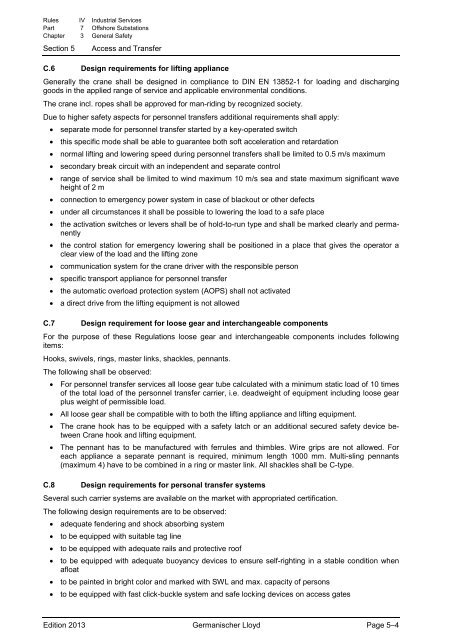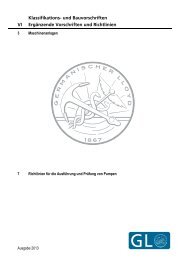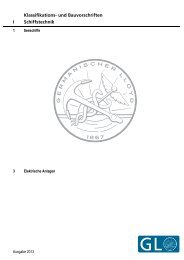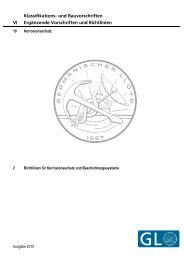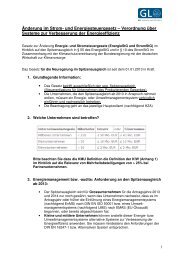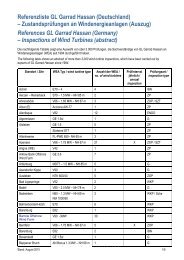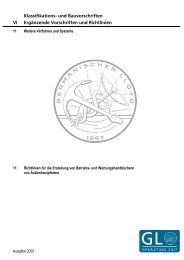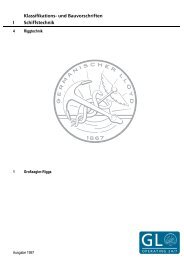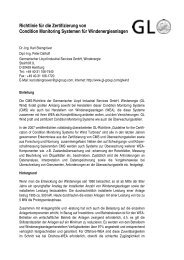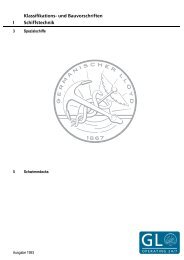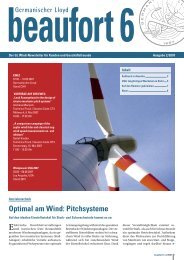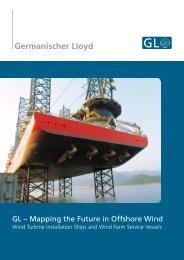(IV-7-3) General Safety
(IV-7-3) General Safety
(IV-7-3) General Safety
Create successful ePaper yourself
Turn your PDF publications into a flip-book with our unique Google optimized e-Paper software.
Rules <strong>IV</strong> Industrial Services<br />
Part 7 Offshore Substations<br />
Chapter 3 <strong>General</strong> <strong>Safety</strong><br />
Section 5<br />
Access and Transfer<br />
C.6 Design requirements for lifting appliance<br />
<strong>General</strong>ly the crane shall be designed in compliance to DIN EN 13852-1 for loading and discharging<br />
goods in the applied range of service and applicable environmental conditions.<br />
The crane incl. ropes shall be approved for man-riding by recognized society.<br />
Due to higher safety aspects for personnel transfers additional requirements shall apply:<br />
• separate mode for personnel transfer started by a key-operated switch<br />
• this specific mode shall be able to guarantee both soft acceleration and retardation<br />
• normal lifting and lowering speed during personnel transfers shall be limited to 0.5 m/s maximum<br />
• secondary break circuit with an independent and separate control<br />
• range of service shall be limited to wind maximum 10 m/s sea and state maximum significant wave<br />
height of 2 m<br />
• connection to emergency power system in case of blackout or other defects<br />
• under all circumstances it shall be possible to lowering the load to a safe place<br />
• the activation switches or levers shall be of hold-to-run type and shall be marked clearly and permanently<br />
• the control station for emergency lowering shall be positioned in a place that gives the operator a<br />
clear view of the load and the lifting zone<br />
• communication system for the crane driver with the responsible person<br />
• specific transport appliance for personnel transfer<br />
• the automatic overload protection system (AOPS) shall not activated<br />
• a direct drive from the lifting equipment is not allowed<br />
C.7 Design requirement for loose gear and interchangeable components<br />
For the purpose of these Regulations loose gear and interchangeable components includes following<br />
items:<br />
Hooks, swivels, rings, master links, shackles, pennants.<br />
The following shall be observed:<br />
• For personnel transfer services all loose gear tube calculated with a minimum static load of 10 times<br />
of the total load of the personnel transfer carrier, i.e. deadweight of equipment including loose gear<br />
plus weight of permissible load.<br />
• All loose gear shall be compatible with to both the lifting appliance and lifting equipment.<br />
• The crane hook has to be equipped with a safety latch or an additional secured safety device between<br />
Crane hook and lifting equipment.<br />
• The pennant has to be manufactured with ferrules and thimbles. Wire grips are not allowed. For<br />
each appliance a separate pennant is required, minimum length 1000 mm. Multi-sling pennants<br />
(maximum 4) have to be combined in a ring or master link. All shackles shall be C-type.<br />
C.8 Design requirements for personal transfer systems<br />
Several such carrier systems are available on the market with appropriated certification.<br />
The following design requirements are to be observed:<br />
• adequate fendering and shock absorbing system<br />
• to be equipped with suitable tag line<br />
• to be equipped with adequate rails and protective roof<br />
• to be equipped with adequate buoyancy devices to ensure self-righting in a stable condition when<br />
afloat<br />
• to be painted in bright color and marked with SWL and max. capacity of persons<br />
• to be equipped with fast click-buckle system and safe locking devices on access gates<br />
Edition 2013 Germanischer Lloyd Page 5–4


